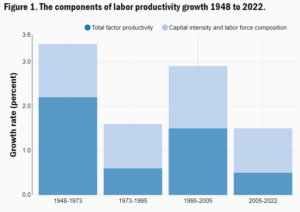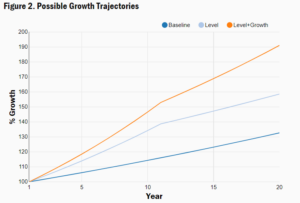
The global economy is facing a host of challenges that can redefine economic growth and stability. Among these challenges, artificial intelligence stands out as both a disruptive force and a transformative solution. As economies grapple with the repercussions of prolonged productivity stagnation, AI presents itself as a beacon of potential that can redefine the very nature of efficiency and precision across various sectors.
The troubling decline in productivity growth in recent decades, particularly pronounced since the financial crisis of 2008, has been a drag on global economic vitality. Countries across the world have wrestled with the effects: sluggish growth rates, persistent inflationary pressures, and an overall underutilisation of economic potential. In this context, AI emerges not merely as a technological innovation but as a crucial lever capable of propelling economies beyond current limitations, offering a pathway to revitalised productivity and enhanced economic outcomes.
READ I AI leadership: India seeks to bridge gap between ambition and reality
AI can spur productivity growth
The potential of AI to revolutionise productivity springs from its capacity to perform tasks with efficiency and precision that far surpass human capabilities. For instance, AI systems like AlphaFold have demonstrated their ability to predict the 3D structures of proteins — an advance that expedites biological research and pharmaceutical development. Such breakthroughs are indicative of AI’s broader potential to serve as a powerful lever in various sectors, including manufacturing, healthcare, and financial services.


Moreover, the integration of AI can help address the supply constraints that have plagued the global economy. With advanced robotics and machine learning, industries can optimise production processes, reduce waste, and manage resources more effectively, thereby easing the supply bottlenecks that contribute to inflation.
Solutions to supply chain disruptions
Beyond productivity, AI is key to solving the problems of an increasingly fragmented global supply chain. Geopolitical tensions and frequent economic shocks — ranging from pandemics to wars — have forced countries and companies to rethink their dependencies and supply strategies. The reconfiguration of these supply chains, driven by a shift towards friend-shoring and diversified sourcing, is both a response to and a catalyst for AI adoption. By employing advanced analytics and machine learning, businesses can better predict disruptions and adapt their logistics strategies, thereby mitigating risks associated with geopolitical instability.
The impact of AI extends beyond mere productivity enhancement. It promises a redefinition of work itself, automating routine and repetitive tasks, and freeing human labour for creative and strategic pursuits. This shift could lead to significant gains in quality of life and job satisfaction, as well as spur innovation.
Demographic shifts present another critical challenge that AI could help address. Many developed economies face aging populations, leading to labour shortages and increased pressure on welfare systems. AI and automation offer potential relief by filling gaps in the workforce, especially in sectors like healthcare and manufacturing. Moreover, AI can facilitate remote work and global collaboration, tapping into a broader pool of talent and counteracting the demographic headwinds. This transition, however, must be managed with care to ensure it does not exacerbate existing social divisions or lead to greater economic insecurity for vulnerable populations.
The role of AI extends into environmental sustainability, offering tools to combat climate change — a force that contributes significantly to global economic volatility. Through predictive modelling and data analysis, AI can optimise energy use in industries, enhance the efficiency of renewable energy systems, and improve resource management. Such applications not only contribute to productivity but also align with global sustainability goals. The challenge lies in ensuring these AI solutions are accessible across different regions and economies, preventing a digital divide in environmental management.
The world must exercise caution against the uncritical embrace of AI. There are risks such as the potential for job displacement, ethical concerns related to data privacy, and the unpredictability of AI systems. Moreover, there is the fear of ‘automation bias’— over-reliance on AI recommendations without adequate oversight, which could lead to errors and misjudgements.
These is a need to address these challenges with a balanced approach, where AI deployment is complemented by robust regulatory frameworks and continuous assessment of its societal impacts. Policymakers must ensure that the benefits of AI are broadly shared, preventing an increase in inequality and addressing the needs of those displaced by technological change.
The question, then, is not merely whether AI can reverse the productivity slowdown — it undoubtedly has that potential — but whether we can harness this technology in a way that promotes a more prosperous, equitable, and sustainable future. The choices we make now will shape not just economic trajectories but the very fabric of our societies.
